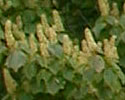Acer spicatum (Mountain Maple)
| Also known as: | |
|---|---|
| Genus: | Acer |
| Family: | Sapindaceae (Soapberry) |
| Life cycle: | perennial woody |
| Origin: | native |
| Habitat: | part shade, sun; moist; forests, thickets, conifer swamps |
| Bloom season: | June - July |
| Plant height: | 10 to 25 feet |
| Wetland Indicator Status: | none |
| MN county distribution (click map to enlarge): |  |
| National distribution (click map to enlarge): |  |
Pick an image for a larger view. See the glossary for icon descriptions.
Detailed Information
Flower: 

![[photo of flowers]](/udata/r9ndp23q/pd3/acer-spicatum-749370-1-t.jpg) Upright or nodding, columnar panicles 1½ to 3 inches tall and an inch or more wide, appearing after leaves are fully developed. Male and female flowers are typically present in same cluster, perfect flowers (both male and female parts) may also be present. All flowers are greenish yellow, about 3/16 of an inch across, with 5 lance-linear petals between 1/16 to over 1/8 inch long and 5 obscure sepals 1/16 inch long or less. Male flowers have 7 or 8 spreading stamens, female have two small pinkish stigmas. Flower stalks are ¼ to 3/8 inch long and hairy.
Upright or nodding, columnar panicles 1½ to 3 inches tall and an inch or more wide, appearing after leaves are fully developed. Male and female flowers are typically present in same cluster, perfect flowers (both male and female parts) may also be present. All flowers are greenish yellow, about 3/16 of an inch across, with 5 lance-linear petals between 1/16 to over 1/8 inch long and 5 obscure sepals 1/16 inch long or less. Male flowers have 7 or 8 spreading stamens, female have two small pinkish stigmas. Flower stalks are ¼ to 3/8 inch long and hairy.
Leaves and stems: 


![[photo of leaves]](/udata/r9ndp23q/trees/acer-spicatum-mountain-maple-leaf-t.jpg) Leaves are simple and opposite, the blade up to 5½ inches long and nearly as wide, heart-shaped at the base, with 3 to 5 palmate lobes. The two basal lobes are typically no more than a larger tooth along the serrated edge. The stalk is less than or equal to the length of the blade and is typically quite red. Upper surface is dark green and smooth, but strongly textured by the veins, the lower surface is paler with fine hairs. Leaves turn to yellow then orange or red in fall.
One year old twigs are brown to reddish, sometimes with a purplish cast, and hairy. Older branches and trunk are mottled gray, smooth or somewhat rough. Trunks are multiple in clumps, rarely getting over 3 inches in diameter at breast height (dbh).
Leaves are simple and opposite, the blade up to 5½ inches long and nearly as wide, heart-shaped at the base, with 3 to 5 palmate lobes. The two basal lobes are typically no more than a larger tooth along the serrated edge. The stalk is less than or equal to the length of the blade and is typically quite red. Upper surface is dark green and smooth, but strongly textured by the veins, the lower surface is paler with fine hairs. Leaves turn to yellow then orange or red in fall.
One year old twigs are brown to reddish, sometimes with a purplish cast, and hairy. Older branches and trunk are mottled gray, smooth or somewhat rough. Trunks are multiple in clumps, rarely getting over 3 inches in diameter at breast height (dbh).
Fruit: 
![[photo of fruit]](/udata/r9ndp23q/pd3/acer-spicatum-279-2-t.jpg) Fruit is a pair of winged seeds (samara), that can be up to 1½ inches long but more typically around an inch, and often turning bright red. Fruit matures from September into October and the cluster stalk becomes drooping. The wings form an angle near 90 degrees.
Fruit is a pair of winged seeds (samara), that can be up to 1½ inches long but more typically around an inch, and often turning bright red. Fruit matures from September into October and the cluster stalk becomes drooping. The wings form an angle near 90 degrees.
Notes:
Mountain Maple is the smallest of Minnesota's native Acer species, growing as a tall shrub or small tree. As its name suggests, it is a cool temperature species and in its eastern US range it only goes south in the higher elevations of the Appalachians. In Minnesota it is frequent along the north shore of Lake Superior and up through the Arrowhead, becoming less common westward. In our SE it prefers cooler north and east facing slopes in the understory of larger trees. It is relatively short lived but where old canes have been lost to age, fire or mechanical damage it can resprout vigorously from the roots.
Native Plant Nurseries, Restoration and Landscaping Services ↓
More photos
Photos courtesy Peter M. Dziuk taken in Aitkin, Cook and Lake counties
Comments
Have you seen this plant in Minnesota, or have any other comments about it?
on: 2015-11-23 13:16:51
The seeds are very pink in the fall! I have a great photograph if you wish to use.







 Mountain Maple shrubs
Mountain Maple shrubs fall color
fall color fall color
fall color a branch
a branch blooming Mountain Maple
blooming Mountain Maple